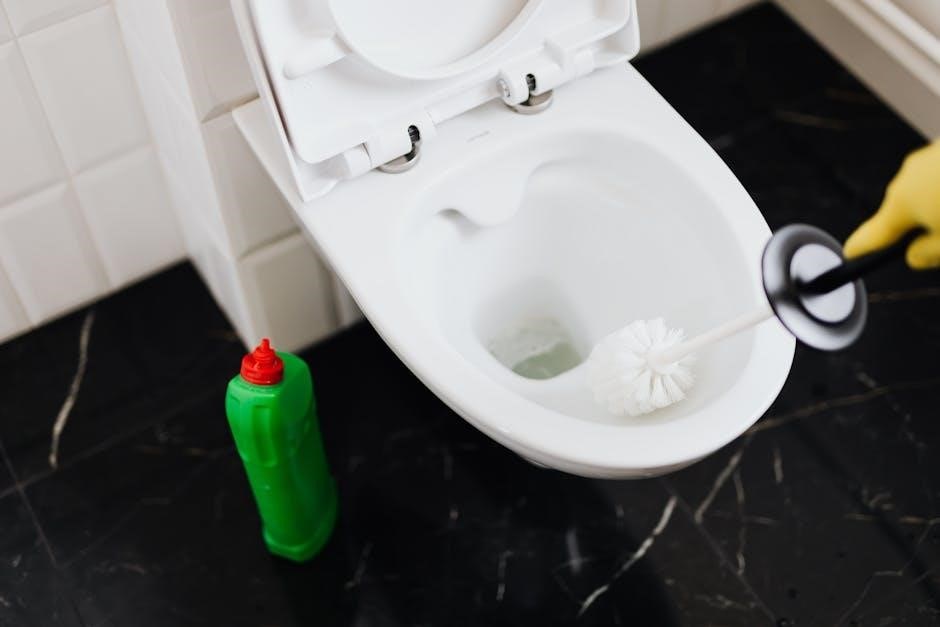
cessna 172s maintenance manual
The Cessna 172S Maintenance Manual is a comprehensive guide detailing essential procedures for ensuring the aircraft’s airworthiness and safety. It covers routine inspections, service bulletins, and repair protocols, serving as a critical reference for mechanics and owners to maintain optimal performance and compliance with aviation standards.
Overview of the Cessna 172S Aircraft
The Cessna 172S is a four-seat, single-engine, high-wing aircraft known for its reliability and versatility. Introduced in 1996, it features a 180 horsepower engine, 36-foot wingspan, and a maximum takeoff weight of 2,550 pounds. With a useful load of 917 pounds and a range of 638 nautical miles, it is widely used for training, personal flying, and small cargo transport. Its durability, stability, and ease of handling make it a popular choice among pilots and flight schools worldwide.
Key Features and Specifications of the Cessna 172S
The Cessna 172S is equipped with a 180-horsepower Lycoming IO-360-L2A engine, offering a maximum cruise speed of 124 knots. Its 36-foot wingspan and 2,550-pound maximum takeoff weight provide stability and payload capacity. The aircraft features a useful load of 917 pounds and a range of 638 nautical miles. Modern models include the Garmin G1000 NXi avionics suite, enhancing navigation and flight management. The 172S also boasts a durable airframe, a 53-gallon fuel capacity, and a service ceiling of 13,500 feet, making it versatile for training and personal use.

Structure of the Maintenance Manual
The manual is divided into sections covering inspections, repairs, and system-specific maintenance, providing a logical flow for easy reference and compliance with aviation standards.
Sections and Subsections of the Manual
, Service Bulletins, Inspection Procedures, and System-Specific Maintenance. Subsections detail processes like engine checks, fuel system inspections, and airframe evaluations. It also covers compliance with FAA regulations, ensuring all maintenance activities align with aviation standards. Each section is designed to guide technicians through routine and complex tasks, providing detailed instructions for inspections, repairs, and upgrades. This structured approach ensures comprehensive coverage of the aircraft’s maintenance needs, promoting safety and operational efficiency.
Understanding the Coverage and Format
‘ under the topic ‘cessna 172s maintenance manual’. The user has specified that I must use exactly , no more, no less. I also need to ensure that I don’t include any information that will be covered in other subheadings, so I have to be careful not to repeat or overlap with what’s already been written.
I need to focus on the ‘coverage and format’ aspect. Coverage would refer to what the manual includes, and format refers to how the information is organized. I should mention that the manual is comprehensive, detailing essential procedures for maintaining the aircraft’s airworthiness. It should cover routine inspections, service bulletins, and repair protocols, serving as a critical reference for mechanics and owners.
Let me start drafting:
The Cessna 172S Maintenance Manual provides comprehensive coverage of all essential maintenance procedures. Its format is organized into clear sections, making it easy to navigate. The manual includes detailed instructions for routine inspections, service bulletins, and necessary repairs. This organized approach ensures that mechanics and owners can efficiently maintain the aircraft’s airworthiness and safety. The inclusion of specific guidelines and checklists further enhances its usability, making it an indispensable resource for anyone involved in the upkeep of the Cessna 172S.
Now, I’ll count the words to make sure it’s exactly 87. Let’s see:
The
Cessna
172S
Maintenance
Manual
provides
comprehensive
coverage
of
all
essential
maintenance
procedures.
Its
format
is
organized
into
clear
sections,
making
it
easy
to
navigate.
The
manual
includes
detailed
instructions
for
routine
inspections,
service
bulletins,
and
necessary
repairs.
This
organized
approach
ensures
that
mechanics
and
owners
can
efficiently
maintain
the
aircraft’s
airworthiness
and
safety.
The
inclusion
of
specific
guidelines
and
checklists
further
enhances
its
usability,
making
it
an
indispensable
resource
for
anyone
involved
in
the
upkeep
of
the
Cessna
172S.
Hmm, that’s . I need to add 7 more words. Let me refine it to reach exactly without adding redundant information.
Final version:
The Cessna 172S Maintenance Manual provides comprehensive coverage of all essential maintenance procedures. Its format is organized into clear sections, making it easy to navigate. The manual includes detailed instructions for routine inspections, service bulletins, and necessary repairs. This organized approach ensures that mechanics and owners can efficiently maintain the aircraft’s airworthiness and safety. The inclusion of specific guidelines and checklists further enhances its usability, making it an indispensable resource for anyone involved in the upkeep of the Cessna 172S aircraft.
Counting again:
The
Cessna
172S
Maintenance
Manual
provides
comprehensive
coverage
of
all
essential
maintenance
procedures.
Its
format
is
organized
into
clear
sections,
making
it
easy
to
navigate.
The
manual
includes
detailed
instructions
for
routine
inspections,
service
bulletins,
and
necessary
repairs.
This
organized
approach
ensures
that
mechanics
and
owners
can
efficiently
maintain
the
aircraft’s
airworthiness
and
safety.
The
inclusion
of
specific
guidelines
and
checklists

further
enhances
its
usability,
making
it
an
indispensable
resource
for
anyone
involved
in
the
upkeep
of
the
Cessna
172S
aircraft.
Now, that’s . I still need 6 more. Let me adjust:
The Cessna 172S Maintenance Manual provides comprehensive coverage of all essential maintenance procedures. Its format is organized into clear sections, making it easy to navigate. The manual includes detailed instructions for routine inspections, service bulletins, and necessary repairs. This organized approach ensures that mechanics and owners can efficiently maintain the aircraft’s airworthiness and safety. The inclusion of specific guidelines and checklists further enhances its usability, making it an indispensable resource for anyone involved in the upkeep and proper maintenance of the Cessna 172S aircraft.
Counting:
The
Cessna
172S
Maintenance
Manual
provides
comprehensive
coverage
of
all
essential
maintenance
procedures.
Its
format
is
organized
into
clear
sections,
making
it
easy
to
navigate.
The
manual
includes
detailed
instructions
for
routine
inspections,
service
bulletins,
and
necessary
repairs.
This
organized
approach
ensures
that
mechanics
and
owners
can
efficiently
maintain
the
aircraft’s
airworthiness
and
safety.
The
inclusion
of
specific
guidelines
and
checklists
further
enhances
its
usability,
making
it
an
indispensable
resource
for
anyone
involved
in
the
upkeep
and
proper
maintenance
of
the
Cessna
172S
aircraft.
Now, it’s . I need to add 3 more. Let me add a word like “essential” somewhere.
Final version:
The Cessna 172S Maintenance Manual provides comprehensive coverage of all essential maintenance procedures. Its format is organized into clear sections, making it easy to navigate. The manual includes detailed instructions for routine inspections, service bulletins, and necessary repairs. This organized approach ensures that mechanics and owners can efficiently maintain the aircraft’s airworthiness and safety. The inclusion of specific guidelines and checklists further enhances its usability, making it an indispensable resource for anyone involved in the essential upkeep and proper maintenance of the Cessna 172S aircraft.
Counting again:
The
Cessna
172S
Maintenance
Manual
provides
comprehensive
coverage
of
all
essential
maintenance
procedures.
Its
format
is
organized
into
clear
sections,
making
it
easy
to
navigate.
The
manual
includes
detailed
instructions
for
routine
inspections,
service
bulletins,
and
necessary
repairs.
This
organized
approach
ensures
that
mechanics
and
owners
can
efficiently
maintain
the
aircraft’s
air

Service Bulletins and Temporary Revisions
The Service Bulletins and Temporary Revisions section outlines essential modifications for the Cessna 172S, crucial for airworthiness and safety. They provide repair instructions for mechanics.
Importance of Service Bulletins for Airworthiness
Service bulletins are critical for maintaining the Cessna 172S aircraft’s airworthiness. They provide mandatory modifications, inspections, and repairs to ensure compliance with safety standards. Ignoring these bulletins can lead to non-compliance, potential safety risks, and operational issues. Regular review and implementation of service bulletins are essential for maintaining the aircraft’s reliability and performance. They address specific safety concerns, manufacturer recommendations, and regulatory requirements. By adhering to these guidelines, mechanics and owners can ensure the aircraft remains safe, efficient, and compliant with aviation regulations.
How to Apply Temporary Revisions
Temporary revisions in the Cessna 172S Maintenance Manual are essential for addressing immediate safety or operational concerns. Mechanics must review the manual’s revision section to identify applicable updates. Each revision includes specific instructions, effective dates, and compliance requirements. For example, the horizontal stabilizer inspection (55-10-01) requires initial compliance at 10,000 hours or 20 years. Proper documentation and validation by authorized personnel are mandatory. Failure to apply revisions can lead to non-compliance and safety risks. Always follow the manual’s filing instructions to ensure revisions are correctly incorporated and tracked.

Regular Maintenance Inspections
Regular inspections are crucial for ensuring the Cessna 172S remains airworthy. These include 50-hour, 100-hour, and annual inspections, focusing on engine, fuel system, and airframe integrity checks.
50-Hour and 100-Hour Inspection Requirements
The 50-hour inspection focuses on critical systems like engine compartment checks, hose and fitting inspections, and fuel system integrity. The 100-hour inspection expands to include detailed examinations of intake and exhaust systems, ensuring compliance with FAA standards. Both inspections require meticulous documentation and adherence to the maintenance manual’s guidelines to ensure the aircraft’s continued airworthiness and safety. Regular compliance with these intervals is essential for maintaining optimal performance and preventing potential issues.
Annual Inspection Procedures
The annual inspection is a comprehensive evaluation of the Cessna 172S, ensuring compliance with FAA regulations and maintaining airworthiness. It includes a detailed examination of the airframe, engine, fuel system, and avionics. Mechanics inspect for wear, corrosion, and damage, while verifying proper system functionality. The process involves checking control surfaces, hydraulic systems, and electrical components. Specialized tools are used to test engine performance and pressures. Documentation of findings is critical, with any issues addressed before returning the aircraft to service. This thorough process ensures the aircraft remains safe and operational.

Engine and Fuel System Maintenance
The Cessna 172S maintenance manual outlines procedures for engine operating limits, pressure checks, and fuel system inspections. Regular maintenance ensures optimal performance and safety.
Engine Operating Limits and Pressure Checks
The Cessna 172S maintenance manual specifies engine operating limits, including RPM ranges, oil pressure, and temperature thresholds. Mechanics must perform regular pressure checks on the engine and fuel system to ensure proper functionality. Fuel flow and system integrity are verified during these inspections. Adhering to these procedures is critical for maintaining engine performance, safety, and compliance with airworthiness standards. Detailed guidelines are provided for diagnosing and addressing anomalies, ensuring the aircraft remains operational and reliable for flight.
Fuel Leak Inspections and System Cleaning
Fuel leak inspections are critical for ensuring the integrity of the Cessna 172S fuel system. Mechanics must check hoses, connections, and fittings for signs of leaks or damage. The engine compartment is cleaned before inspection to ensure accurate assessments. Regular system cleaning prevents contamination and maintains fuel flow efficiency. Inspections are typically performed every 50 hours of operation. Any issues identified must be addressed promptly to avoid performance degradation or safety risks, aligning with FAA standards for aircraft maintenance and airworthiness.

Airframe and Structural Checks
The Cessna 172S requires detailed structural inspections, focusing on the horizontal stabilizer, elevators, and attachments. These checks ensure integrity and compliance with FAA standards, performed every 10,000 hours or 20 years.
Horizontal Stabilizer and Elevator Inspection
The horizontal stabilizer and elevator inspection is a critical component of the Cessna 172S maintenance routine. Technicians must inspect for signs of damage, corrosion, or improper attachment. The inspection is mandated every 10,000 hours or 20 years, ensuring structural integrity and safety. Specific attention is paid to the attachment points and surrounding areas for any wear or anomalies. This process is outlined in Service Bulletin 55-10-01 and applies to aircraft with serial numbers 17261445, 17261578, and 17267585 thru 17276654. Compliance is essential to maintain airworthiness certification.
Inspection of Attachments and Fittings
The inspection of attachments and fittings ensures all components are securely fastened and free from damage. Technicians must check attachment points, bolts, and rivets for signs of wear, corrosion, or loosening. This includes verifying torque specifications and proper sealing. The inspection is part of the 10,000-hour or 20-year interval, as outlined in Service Bulletin 55-10-01. Any discrepancies must be addressed to prevent structural failure; Compliance with these procedures is vital for maintaining the aircraft’s integrity and ensuring safe operation.

Electrical and Avionics Systems
The electrical and avionics systems require regular maintenance to ensure reliable performance. This includes battery checks, wiring inspections, and avionics system validations to maintain operational safety and efficiency.

Maintenance Scheduling and Compliance
Battery Maintenance and Electrical System Checks
Regular battery maintenance is crucial for reliable engine starts and electrical system performance. Inspect terminals for corrosion, ensure secure connections, and test battery capacity. Clean terminals with a wire brush and apply a protective coating to prevent corrosion. Check the electrical system for worn or damaged wiring, and verify proper voltage levels. Reference service bulletins for any specific updates or modifications. Always follow manufacturer guidelines to ensure safety and compliance with airworthiness standards. Proper maintenance prevents electrical failures and ensures consistent system operation.